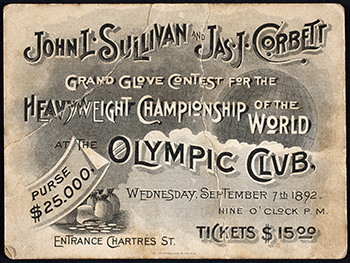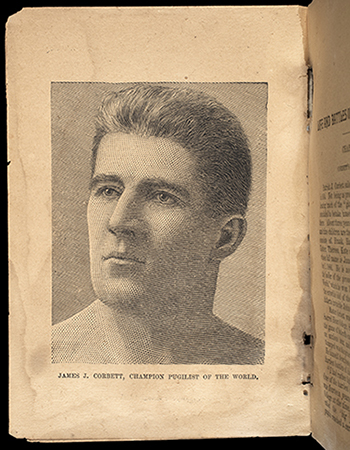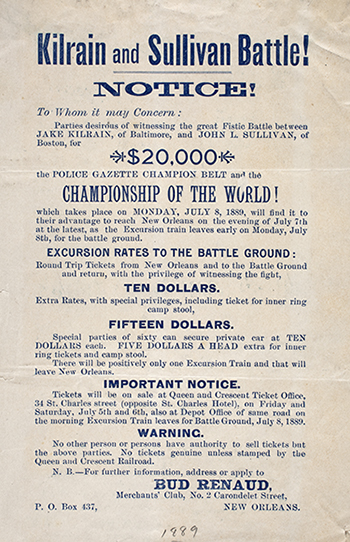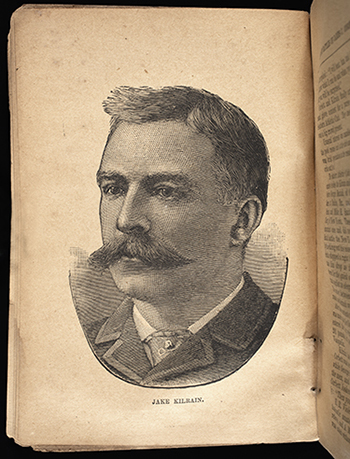Big Fights in Special Collections
 Most boxing fans remember New Orleans as the site of the famous Sugar Ray Leonard vs. Roberto Durán “No Más Fight” in the Superdome on November 25, 1980, but in the late nineteenth century, the Crescent City stood as one of the major centers of American prizefighting, long before the rise of Las Vegas and Atlantic City. Three artifacts in the LSU Libraries' Special Collections remind us of these rowdy early days of boxing in America and its first great heavyweight champion, John L. Sullivan.
Most boxing fans remember New Orleans as the site of the famous Sugar Ray Leonard vs. Roberto Durán “No Más Fight” in the Superdome on November 25, 1980, but in the late nineteenth century, the Crescent City stood as one of the major centers of American prizefighting, long before the rise of Las Vegas and Atlantic City. Three artifacts in the LSU Libraries' Special Collections remind us of these rowdy early days of boxing in America and its first great heavyweight champion, John L. Sullivan.
Although widely popular, prizefighting was banned almost everywhere in the United States in the late nineteenth century. Instead, fights were held in legal no-man’s-lands like offshore barges, coastal islands, and even in more tolerant Havana, Cuba. One championship fight in 1896 was waged on a sandbar in the Rio Grande to evade both Mexican and Texan authorities. In the months before a match, fight promoters would instruct fans to gather in a particular city around a certain date where they would purchase train tickets for a surreptitious journey to a secluded venue known only to the promoter. John L. Sullivan of Boston won his heavyweight championship in one of these “fight-and-dash” bouts, a nine-round, eleven-minute trouncing of the out-of-shape and outmatched champion, Paddy Ryan, on February 7, 1882 (rounds were untimed and unlimited under the London Prize Ring Rules that governed bare knuckle prizefighting, ending only when a man was knocked or thrown to the turf). Fight enthusiasts had gathered beforehand in New Orleans to board trains for the match held at a hotel in Mississippi City, Mississippi, on the coast near Gulfport.
The Jake Kilrain vs. John L. Sullivan Championship Prize Fight Broadside (1889) advertised another flagrantly illegal bout, as the instructions to fight fans made abundantly clear. Again, New Orleans became the gathering place for members of “the Fancy” eager to see Sullivan defend his title against Jake Kilrain in the last bare knuckle heavyweight championship bout in American history. Evading militia in both Louisiana and Mississippi, the trains departed New Orleans for a hilltop in the pine forest near Richburg, Mississippi, just south of Hattiesburg. There on July 8, 1889, under a scorching summer sun, Sullivan outlasted Kilrain for 75 rounds over two hours, sixteen minutes, to remain champion.
Three years later, Sullivan defended his title against “Gentleman Jim” Corbett at the Olympic Club in New Orleans, remembered here with the John L. Sullivan and James J. Corbett Grand Glove Contest Ticket (1892). The first heavyweight championship fought under the Marquess of Queensberry Rules—the rules of modern boxing mandating the use of gloves, three-minute rounds, and a ten-count—the bout was a legal one because it was a gloved contest rather than a bare knuckle prizefight. Without the need to dodge authorities, the match was held in a new arena lit by electric lights and holding ten thousand spectators bearing event tickets (rather than train tickets) like this one on September 7, 1892.
 Sullivan had not fought since beating Kilrain in 1889 and had clearly reached the end of his career. Eight years younger than the champ, Corbett wore down Sullivan for an easy knockout in the twenty-first round, giving the “Boston Strong Boy” his first and only defeat of his career. A round-by-round account of the fight appeared in Life and Battles of James J. Corbett, the Champion Pugilist of the World (1892), a laudatory popular account of Corbett’s life and boxing career published by Richard Kyle Fox, editor of the National Police Gazette, the leading men’s sporting magazine of the day.
Sullivan had not fought since beating Kilrain in 1889 and had clearly reached the end of his career. Eight years younger than the champ, Corbett wore down Sullivan for an easy knockout in the twenty-first round, giving the “Boston Strong Boy” his first and only defeat of his career. A round-by-round account of the fight appeared in Life and Battles of James J. Corbett, the Champion Pugilist of the World (1892), a laudatory popular account of Corbett’s life and boxing career published by Richard Kyle Fox, editor of the National Police Gazette, the leading men’s sporting magazine of the day.
The broadside and ticket are in the LLMVC Ephemera Collection Subgroup VI. Richard Kyle Fox’s Life and Battles of James J. Corbett, the Champion Pugilist of the World (New York: R.K. Fox, 1892) is in Hill Memorial Library, call number: GV 1132 .C7 F7 (LLMVC).
To learn more about John L. Sullivan, the New Orleans sporting scene, and the world of late-Victorian boxing, see:
Michael T. Isenberg, John L. Sullivan and His America (Urbana: University of Illinois Press, 1988) in Middleton Library GV 1132 .S95 I84 1988
Dale A. Somers, The Rise of Sports in New Orleans, 1850-1900 (Baton Rouge: Louisiana State University Press, 1972) in Hill & Middleton Libraries GV 584.5 .N38 S6


